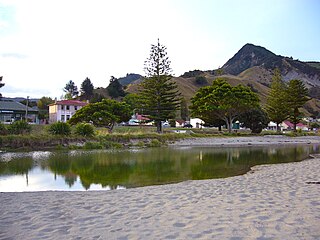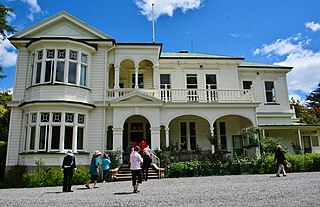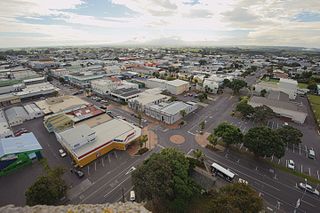Demographics
Tarata statistical area, which also includes Purangi, covers 258.97 km2 (99.99 sq mi) [3] and had an estimated population of 620 as of June 2022, [4] with a population density of 2.4 people per km2.
Historical population for Tarata statistical area| Year | Pop. | ±% p.a. |
|---|
| 2006 | 606 | — |
|---|
| 2013 | 582 | −0.58% |
|---|
| 2018 | 570 | −0.42% |
|---|
| Source: [5] |
Tarata had a population of 570 at the 2018 New Zealand census, a decrease of 12 people (−2.1%) since the 2013 census, and a decrease of 36 people (−5.9%) since the 2006 census. There were 210 households, comprising 312 males and 258 females, giving a sex ratio of 1.21 males per female. The median age was 35.7 years (compared with 37.4 years nationally), with 141 people (24.7%) aged under 15 years, 93 (16.3%) aged 15 to 29, 285 (50.0%) aged 30 to 64, and 45 (7.9%) aged 65 or older.
Ethnicities were 95.8% European/Pākehā, 13.7% Māori, 0.5% Pacific peoples, and 3.2% other ethnicities. People may identify with more than one ethnicity.
The percentage of people born overseas was 7.9, compared with 27.1% nationally.
Although some people chose not to answer the census's question about religious affiliation, 53.7% had no religion, 37.4% were Christian and 1.6% had other religions.
Of those at least 15 years old, 45 (10.5%) people had a bachelor's or higher degree, and 75 (17.5%) people had no formal qualifications. The median income was $35,100, compared with $31,800 nationally. 66 people (15.4%) earned over $70,000 compared to 17.2% nationally. The employment status of those at least 15 was that 267 (62.2%) people were employed full-time, 75 (17.5%) were part-time, and 18 (4.2%) were unemployed. [5]

Te Kūiti is a town in the north of the King Country region of the North Island of New Zealand. It lies at the junction of State Highways 3 and 30 and on the North Island Main Trunk railway, 80 kilometres (50 mi) south of Hamilton. The town promotes itself as the sheep shearing capital of the world and is host to the annual New Zealand National Shearing Championships.

Inglewood is a town in the Taranaki Region of New Zealand's North Island. It is 16 kilometres (10 mi) southeast of New Plymouth on State Highway 3, close to Mount Taranaki, and sits 200 metres (660 ft) above sea level. The town services a mainly dairy farming region.

Tokomaru Bay is a small beachside community located on the isolated East Coast of New Zealand's North Island. It is 91 km north of Gisborne, on State Highway 35, and close to Mount Hikurangi. The district was originally known as Toka-a-Namu, which refers to the abundance of sandflies. Over the years the name was altered to Tokomaru Bay.

Tikokino is a town in the Central Hawke's Bay District on the east coast of the North Island of New Zealand. It is located 20 kilometres (12 mi) northwest of Waipawa and 55 kilometres (34 mi) southwest of Hastings. The township is located on State Highway 50.

Tolaga Bay is both a bay and small town on the East Coast of New Zealand's North Island located 45 kilometres northeast of Gisborne and 30 kilometres south of Tokomaru Bay.

Hāwera is the second-largest centre in the Taranaki region of New Zealand's North Island, with a population of 10,400. It is near the coast of the South Taranaki Bight. The origins of the town lie in a government military base that was established in 1866, and the town of Hāwera grew up around a blockhouse in the early 1870s.
Te Teko is a small inland town along the banks of the Rangitaiki River in the Bay of Plenty region of New Zealand's North Island.

Normanby is a small village in South Taranaki, New Zealand. It is approximately 6 km inland from Hawera along State Highway 3. Eltham is 13 km further north.

Reporoa is a rural community in Rotorua Lakes within the Waikato region of New Zealand's North Island.
Urenui is a settlement in northern Taranaki, in the North Island of New Zealand. It is located on State Highway 3 close to the shore of the North Taranaki Bight, 13 kilometres east of Waitara and 6 km south-west of Mimi. The Urenui River flows past the settlement into the North Taranaki Bight.

Nūhaka is a small settlement in the northern Hawke's Bay Region of New Zealand's eastern North Island, lying on State Highway 2 between Wairoa and Gisborne. The road to Mahia turns off the highway at Nūhaka.
Tautoro is a locality about 8 km south-southeast of Kaikohe in Northland, New Zealand. Further to the south is the Awarua rural community.
Pukepoto is a town in Northland, New Zealand. It lies south west of Kaitaia and north east of Ahipara. The Herekino Forest lies to the south east.
Waimā is a community in the south Hokianga area of Northland, New Zealand. State Highway 12 runs through the area. The Waima River flows through the Waima Valley into the Hokianga Harbour. Rawene is to the north west, and Kaikohe is to the north east.
Ohangai is a locality in South Taranaki, New Zealand. It is approximately 10 km east of Hawera and 6 km north of Mokoia
Te Karaka is a small settlement inland from Gisborne, in the northeast of New Zealand's North Island. It is located in the valley of the Waipaoa River close to its junction with its tributary, the Waihora River. Te Karaka is located on State Highway 2, and is the largest settlement between Gisborne and Opotiki in the Bay of Plenty.
Pātūtahi is a small settlement 15 kilometres from Gisborne, in the northeast of New Zealand's North Island. It is located in the valley of the Waipaoa River. From 1915 to 1931 Pātūtahi had a railway station on the Ngātapa Branch.
Manutūkē is a settlement in the Gisborne District of New Zealand's North Island. It is located to the west of the city of Gisborne on State Highway 2, close to the mouth of the Waipaoa River.

Waiwhetū is an eastern suburb of Lower Hutt in the Wellington Region situated in the south of the North Island of New Zealand.
Waioeka is a rural community in the Ōpōtiki District and Bay of Plenty Region of New Zealand's North Island. It is on the east bank of the Waioeka River.
This page is based on this
Wikipedia article Text is available under the
CC BY-SA 4.0 license; additional terms may apply.
Images, videos and audio are available under their respective licenses.










